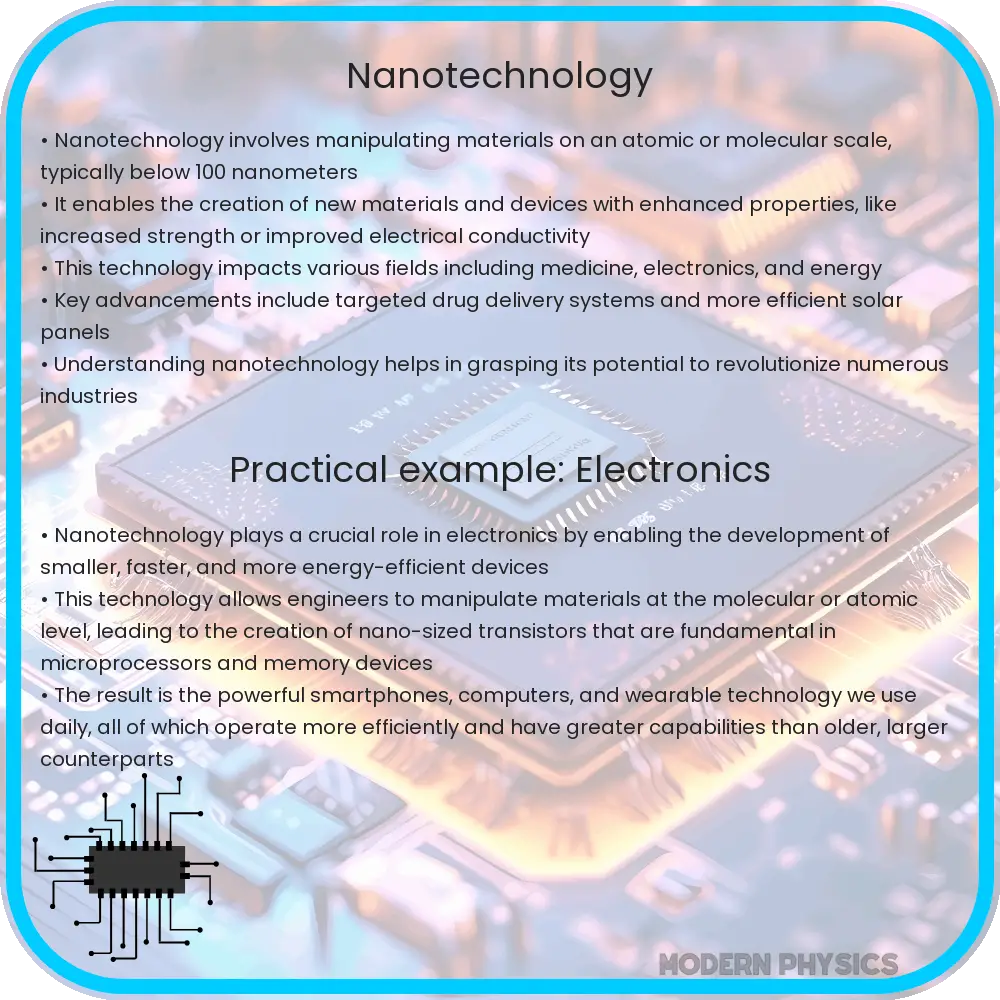Nanotechnology involves manipulating matter at the nanoscale to create innovative materials and devices impacting various industries.

Introduction to Nanotechnology
Nanotechnology is a groundbreaking field of science and engineering that involves the manipulation of matter at an incredibly small scale, typically between 1 and 100 nanometers. To put that into perspective, a single nanometer is one billionth of a meter, making nanotechnology a venture into the atomic and molecular levels. This tiny scale enables scientists to create novel materials and devices across various fields such as electronics, medicine, and energy generation.
Understanding the Scale and Potential of Nanotechnology
At the nanoscale, the physical, chemical, and biological properties of materials differ significantly from those observed in bulk materials. These unique properties include increased strength, lighter weight, enhanced chemical reactivity, and better control of light spectrum, among others. By harnessing these properties, nanotechnology offers the potential to revolutionize a host of industries and societal sectors.
A Closer Look at Innovative Materials in Nanotechnology
- Carbon Nanotubes: Hollow tubes made of carbon atoms that are remarkably strong yet lightweight. They are utilized in creating stronger, more durable materials which are currently being used in aerospace, sports equipment, and potentially in building materials.
- Graphene: A single layer of carbon atoms arranged in a two-dimensional honeycomb lattice. Its superb electrical, thermal, and mechanical properties make it an excellent candidate for use in next-generation electronics, energy storage devices, and even medical applications.
- Quantum Dots: Nanoscale semiconductor particles that have exceptional optical properties that are tunable based on their size. This characteristic makes them ideal for use in items like medical imaging devices, solar cells, and quantum computing.
Innovative Solutions Through Nanotechnology
- Medical Applications: Targeted drug delivery systems at the nanoscale can dramatically improve the efficacy of treatments by ensuring that drugs are delivered precisely where they are needed in the body, minimizing side effects and maximizing the therapeutic effects.
- Environmental Impact: Nanotechnology is paving the way for more efficient methods of consuming resources and producing less waste in industrial processes. Nano-enhanced catalysts, for instance, can lead to cleaners and more efficient chemical reactions, reducing the need for harmful chemicals and emissions.
- Energy Efficiency: With the development of nanotechnology-enabled materials, we see an increase in energy efficiency from solar panels through higher energy conversion rates to lighter and more effective thermal insulation materials.
The Educational and Ethical Considerations of Nanotechnology
As nanotechnology evolves, its implications on society and its ethical considerations become more significant. Education on nanotechnology is crucial for developing informed citizens who understand the benefits and potential dangers of technological advancements. Ethical issues, such as privacy in the age of nano-enabled “smart” surveillance and environmental impacts of nanoscale materials, are also important to consider.
Recent Breakthroughs in Nanotechnology
Recent advancements in nanotechnology continue to push the boundaries of what is scientifically possible. Scientists have developed nano-sized robots that can perform tasks at a cellular level, offering promising insights into future medical treatments for diseases like cancer. In electronics, researchers have utilized nanotechnology to create ultra-thin, flexible displays that could revolutionize mobile and wearable technology.
Challenges and Future Outlook
Despite its vast potential, nanotechnology faces several challenges. The foremost is the technical difficulty associated with manipulating materials at the nanoscale. Additionally, the long-term environmental and health effects of widespread nanotechnological applications are still largely unknown, necessitating cautious and responsible research protocols. Looking ahead, the successful integration of nanotechnology into society will hinge on overcoming these challenges while maximizing its societal benefits.
Conclusion
Nanotechnology is a fascinating field that merges elements of physics, chemistry, biology, and engineering to form solutions that impact numerous aspects of our lives. From revolutionizing medical treatments with nanorobots to creating sustainable environments with nano-enhanced materials, the scope of nanotechnology is vast and full of potential. As we continue to explore and understand this field, it remains crucial for researchers, policymakers, and the public to foster a deep understanding of both its capabilities and its risks. Embracing both its innovations and addressing ethical concerns will be instrumental in leveraging nanotechnology for a better future.
